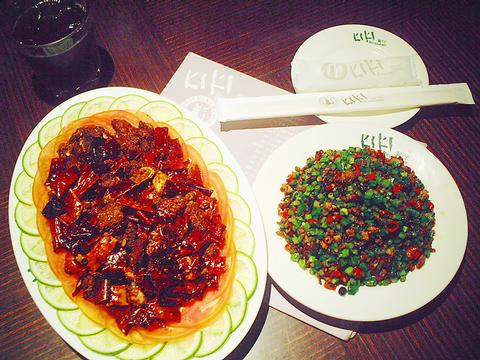While restaurants specializing in hot and spicy Sichuan cuisine are prevalent throughout Taiwan's bustling metropolises, the Kiki Restaurant chain has, over the past decade, built up a reputation not only as one of the classiest of Taipei's numerous Sichuan joints, but also one of the most contemporary.
Kiki offers diners a feast of Sichuan food in an environment far-removed from that of many of the traditional red tableclothed spit-and-sawdust Sichuan joints. With its dim lighting and dark wood furniture, Kiki has all the trappings of a modern European-style eatery rather than that of an Oriental joint. Oriental it is, however, only Oriental with a spicy twist.
"Our aim is to offer diners traditional Sichuan cuisine with a modern twist in even more contemporary surroundings," said employee, You En-lun (

PHOTO: GAVIN PHIPPS, TAIPEI TIMES
The menu is packed with dishes that will set the mouth of even the hardiest chili eater ablaze. And while dishes such steamed and fried egg with pork (
Some of the joints more popular hotter dishes include Taiwanese eel fried with hot chili and pork (
Not all of the joint's dishes are laden with peppers, however. Should diners wish to eat without losing their sense of taste, then dishes such as beef strips with ginger (
While the chiefs at Kiki pride themselves on their spicy dishes, they will make an exception for diners who can't take such large amounts of chili. All the dishes are available with less chili on request.
At present there are four branches of Kiki scattered throughout Taipei. And while they all serve the same fiery selection of food, the largest and most popular branch is the Fuhsing branch, where on occasion celebrities can be spotted mopping their brows as the chili effect kicks in.

One of the biggest sore spots in Taiwan’s historical friendship with the US came in 1979 when US president Jimmy Carter broke off formal diplomatic relations with Taiwan’s Republic of China (ROC) government so that the US could establish relations with the People’s Republic of China (PRC). Taiwan’s derecognition came purely at China’s insistence, and the US took the deal. Retired American diplomat John Tkacik, who for almost decade surrounding that schism, from 1974 to 1982, worked in embassies in Taipei and Beijing and at the Taiwan Desk in Washington DC, recently argued in the Taipei Times that “President Carter’s derecognition

This year will go down in the history books. Taiwan faces enormous turmoil and uncertainty in the coming months. Which political parties are in a good position to handle big changes? All of the main parties are beset with challenges. Taking stock, this column examined the Taiwan People’s Party (TPP) (“Huang Kuo-chang’s choking the life out of the TPP,” May 28, page 12), the Democratic Progressive Party (DPP) (“Challenges amid choppy waters for the DPP,” June 14, page 12) and the Chinese Nationalist Party (KMT) (“KMT struggles to seize opportunities as ‘interesting times’ loom,” June 20, page 11). Times like these can

JUNE 30 to JULY 6 After being routed by the Japanese in the bloody battle of Baguashan (八卦山), Hsu Hsiang (徐驤) and a handful of surviving Hakka fighters sped toward Tainan. There, he would meet with Liu Yung-fu (劉永福), leader of the Black Flag Army who had assumed control of the resisting Republic of Formosa after its president and vice-president fled to China. Hsu, who had been fighting non-stop for over two months from Taoyuan to Changhua, was reportedly injured and exhausted. As the story goes, Liu advised that Hsu take shelter in China to recover and regroup, but Hsu steadfastly

You can tell a lot about a generation from the contents of their cool box: nowadays the barbecue ice bucket is likely to be filled with hard seltzers, non-alcoholic beers and fluorescent BuzzBallz — a particular favorite among Gen Z. Two decades ago, it was WKD, Bacardi Breezers and the odd Smirnoff Ice bobbing in a puddle of melted ice. And while nostalgia may have brought back some alcopops, the new wave of ready-to-drink (RTD) options look and taste noticeably different. It is not just the drinks that have changed, but drinking habits too, driven in part by more health-conscious consumers and